Managing Canine Urine Damage: Lawn Care Tips

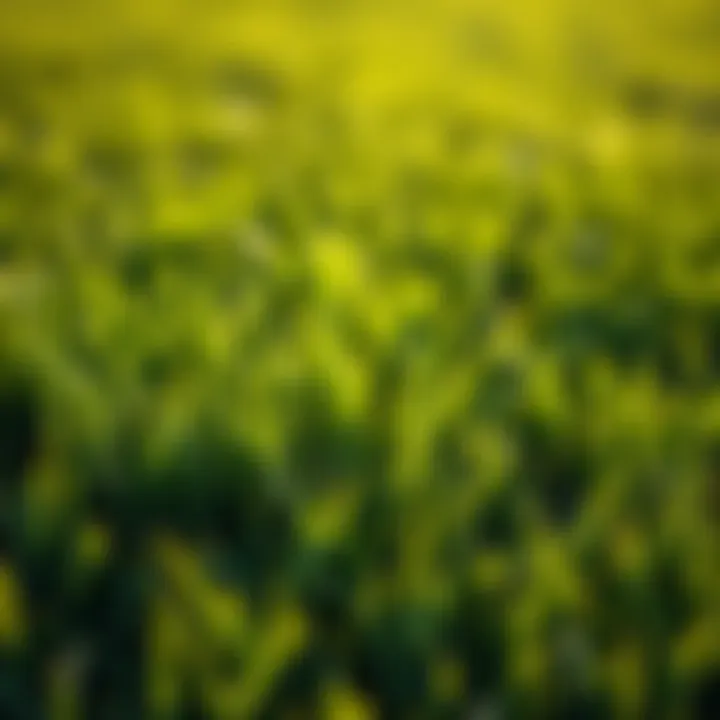
Intro
Managing the health of a lawn can be a challenge, especially for pet owners. Dog urine, often high in nitrogen and other nutrients, can lead to unsightly patches and overall decline in grass quality. Understanding how to mitigate the damage caused by this common issue is essential for both pet lovers and avid gardeners. This article dives into the chemical content of canine urine, how it interacts with various grass types, and strategies to maintain lush, green surroundings.
Key Concepts and Terminology
Basic Definitions
When discussing the impact of dog urine on lawns, it's necessary to define some core concepts:
- Urine burn: This term describes the distinct yellow patches that appear in grass after dog urine application. It's typically caused by nitrogen overload.
- pH levels: The acidity or alkalinity of a substance, which significantly influences plant health. Dog urine tends to be more acidic compared to its environment.
- Dilution technique: A practice of watering immediately after a dog urinates to dilute the urine's concentration on the grass.
Historical Context
The relationship between humans, their pets, and the land they maintain has existed for centuries. Ancient agriculture practices often adapted to pet presence, recognizing that animal waste can both harm and benefit the soil. In modern times, increased urbanization means more pets and less access to open areas, making the management of pet waste essential for lawn health. Knowing how to balance these influences is key to nurturing greener spaces in residential areas.
Recent Innovations and Trends
Technological Advancements
Recent developments in lawn care technology have brought attention to the importance of soil health as it relates to pet urine. Innovations like smart irrigation systems can automatically adjust based on real-time moisture levels, helping to prevent over-saturation and urine burn. Fertilizer formulations have also been created to offset alkalinity issues, providing a neutralizing effect on urine's impact.
Sustainable Practices
As environmental awareness grows, sustainable lawn care practices have gained traction. Natural remedies, such as composting and organic lawn fertilizers, are becoming increasingly popular. Moreover, more pet owners are turning to specially designed grass savers that contain nutrients and beneficial microbes to promote grass recovery after urine exposure.
Practical Applications and Techniques
Step-by-step Guides
- Watering immediately: After your dog urinates, water the area thoroughly. This practice dilutes the urine and reduces its harmful effects on grass.
- Consider grass type: Different grasses have varied resilience to urine. Fescue, for instance, may be more resistant than Kentucky bluegrass. Choose varieties accordingly.
- Use urine-specific grass savers: Products like PawPaw or DogRock can help neutralize urine-related issues. Scatter them in frequent urine spots to facilitate healthier growth.
- Regular lawn maintenance: Aerate and dethatch the lawn at least once a year. This boosts root health and allows for better nutrient uptake, promoting grass resilience.
- Test soil pH: A simple home testing kit can help you understand the soil composition and adjust accordingly with amendments if necessary.
Case Studies
- In a suburban neighborhood in Oregon, residents implemented a community watering schedule for their lawns that coincided with common dog walking times. This simple practice drastically reduced lawn damage from urine and improved overall grass health in the area.
- In a case from Michigan, a pet-friendly park introduced a special blend of fescue that was found to withstand high nitrogen levels better than traditional grass. This not only benefited the grass but also reduced the cost of lawn maintenance significantly.
"Understanding how to balance nitrogen levels and grass type will lead to healthier lawns and happier pets."
By following these guidelines and employing innovative solutions, both pet owners and lawn enthusiasts can reduce the negative impacts of canine urine on their lawns. With some foresight and consistent care, it’s possible to maintain a verdant landscape that thrives amidst the challenges posed by our furry friends.
Prolusion
Managing the effects of canine urine on lawns is no small feat. For many pet owners, the joy of having a furry companion comes with the challenge of maintaining a lush and vibrant yard. Understanding this relationship is critical, as both the health of the grass and the pet's well-being are at stake. With the right knowledge, pet parents can adopt effective strategies that balance the needs of their four-legged friends with the desire for a thriving green space.
A lawn can be a source of pride, a place where family gathers, where children play, and where pets frolic. Yet, beneath the surface, canine urine can wreak havoc on grass health. The urine not only alters the soil chemistry but also has the potential to create dry, patchy areas on land that is otherwise supposed to be lush. So, it’s essential to take a proactive approach to tackle this common dilemma.
This article aims to deeply explore the interplay between pets and grass. By dissecting the chemical components of urine and their respective impacts on lawns, we can shine a light on the numerous signs of distress in grass and highlight actionable prevention techniques. Armed with this knowledge, pet owners will be better equipped to ensure their lawns can flourish.
Understanding the Relationship Between Pets and Grass
The connection between pets and the grass they roam on is often underestimated. Many pet owners may overlook how canine behaviors influence lawn vitality. For instance, dogs tend to favor specific spots for their business, leading to concentrated areas of damage. This repeated exposure to urine doesn’t just affect the grass; it can alter the soil's nutrient balance over time. As pet owners, recognizing this relationship opens doors to addressing any potential problems before they spiral out of control.
Moreover, it is crucial to note that not all grasses react the same way to canine urine. Some grass types are more resilient, while others can succumb to damage more easily. This distinction further underlines the importance of understanding how the two interact.
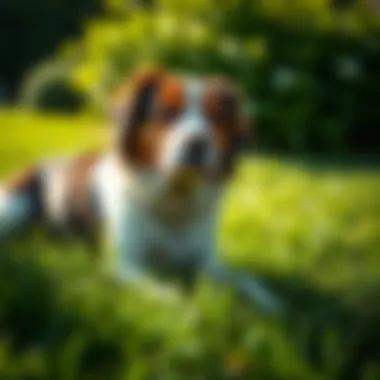
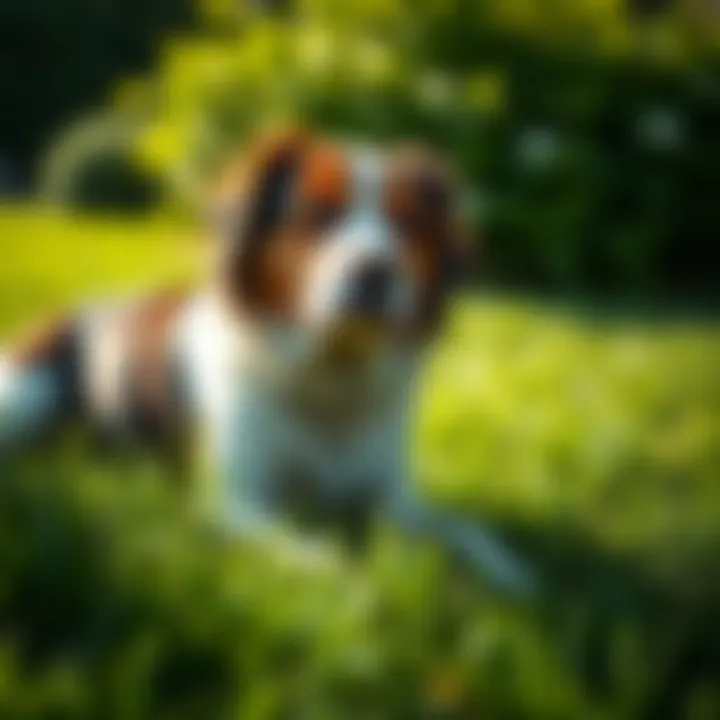
In summary, grasping the dynamics of pet-grass relationships and the implications of urinary discharge can empower pet owners. By choosing appropriate lawn care strategies and considering the individual needs of both pet and grass, one can cultivate an outdoor area that reflects care for their furry mates and the environment.
The Chemistry of Canine Urine
Understanding the chemistry of canine urine is crucial for pet owners and those responsible for maintaining lawns. Dog urine can have varying effects on grass, and recognizing the specific components at play helps in mitigating damage and promoting healthier lawns. Knowing what’s in that puddle can guide effective strategies toward maintaining lush greenery while accommodating beloved pets.
Key Components of Urine
Dog urine is not just water; it’s a cocktail of elements that influences lawn health. Primarily, canine urine consists of the following:
- Urea: The main nitrogenous waste product, urea breaks down into ammonia when exposed to air, which in high concentrations can harm grass.
- Creatinine: This compound results from muscle metabolism and also affects grass differently, though it is less harmful than urea.
- Uric Acid: Present in lower concentrations, it doesn’t evaporate as easily as urea and may contribute to soil salinity.
- Minerals and Salts: Sodium, potassium, and other minerals, which can accumulate, impacting soil chemistry over time.
Recognizing these components allows owners to take tailored action regarding lawn care, ensuring a balance between the needs of their pets and the desire for a pristine lawn.
Nitrogen and Its Impact on Grass
Nitrogen, found abundantly in canine urine, plays a dual role in lawn health. Initially, it acts as a fertilizer, stimulating grass growth and lush greenery. However, excessive nitrogen levels can lead to a range of issues for grass, resulting in:
- Burnt Patches: The classic yellow or brown spots that mar the otherwise green landscape. Intensive nitrogen can essentially scorch the grass blades.
- Thinning Grass: Counterintuitively, too much nitrogen can weaken root systems, making them less resilient.
- Weed Growth: Over-nitrified areas can become breeding grounds for weeds, which often thrive in nutrient-rich soils.
Therefore, while nitrogen can be beneficial, moderation is key. Finding that perfect balance helps foster a resilient lawn, while still respecting the presence of a canine companion.
Salts and Their Role in Lawn Damage
Salts in canine urine, particularly sodium and chloride, can have detrimental effects when left unchecked. The accumulation of salts in soil can lead to:
- Soil Degradation: High salt levels can hinder the plant's ability to absorb water, stressing the grass and leading to wilting and eventual die-off.
- Ineffective Nutrient Uptake: Excess salts disrupt nutrient absorption, essential for healthy plant growth, leading to deficiencies and poor grass health.
- Soil pH Alterations: Salts can alter the pH balance in soil, making it less suitable for grass and other plants.
Overall, understanding the role of salts in lawn care is as important as managing nitrogen levels. This chemical knowledge equips owners with the insight needed to protect their lawns from both immediate and long-term damage.
"An ounce of prevention is worth a pound of cure." This old adage rings true when considering how best to manage pet urine impacts. Knowledge about the chemistry of canine urine arms pet owners with the necessary tools to create harmony between their pets and their outdoor spaces, fostering a landscape that is both inviting to play in and pleasing to the eye.
Recognizing Symptoms of Lawn Damage
Understanding the distress signals your lawn sends is essential for maintaining its health and vigor. Recognizing the symptoms of lawn damage caused by canine urine not only helps in remedying existing issues but also empowers pet owners to implement preventative measures. A well-informed approach can make the difference between a dying patch of grass and a thriving lawn.
Identifying Discoloration Patterns
Discoloration is often the first visible sign of trouble. Two key patterns typically emerge when grass is affected by dog urine:
- Dark green rings: These appear around the spot where the urine was deposited, primarily due to the high nitrogen content that stimulates growth initially but can lead to burnt areas over time.
- Brown patches: As grass struggles to cope with the overwhelming salts in canine urine, it can become scorched, presenting as dead spots within your otherwise vibrant lawn.
Being vigilant in spotting these discoloration patterns can help you address lawn health swiftly. Neglecting such signs may worsen the damage, leading to larger areas of dead grass and an increased amount of work to restore your lawn’s beauty.
Assessing Grass Health: A Practical Approach
To tackle lawn issues effectively, it’s important to have a systematic approach. Here’s how you can assess the overall health of your grass:
- Root examination: Gently pull at the grass to check how deeply the roots are established. Strong, healthy grass should resist pulling slightly. Weak roots may indicate stress, possibly from urine damage.
- Color consistency: Look across the lawn for variations in color. Healthy grass is typically uniform, whereas varied shades can signal trouble spots.
- Test soil moisture: Stick your finger into the soil about an inch deep. If it’s bone dry, your lawn may need more water or a change in watering technique to flush out excess salts from urine.
- Look for pests: Sometimes, the problems we see can be compounded by pests that thrive in stressed environments. Inspect for signs of pests that may be contributing to your lawn’s decline.
It’s wise to regularly monitor these aspects. Early detection and management keep a thriving lawn and aid in addressing any underlying issues, potentially avoiding significant costs in turf renovation later on.
"A smart gardener observes more than just the surface. They understand the narrative their lawn tells."
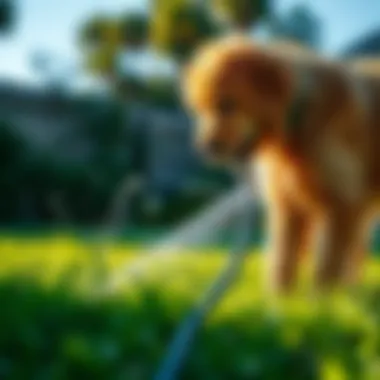
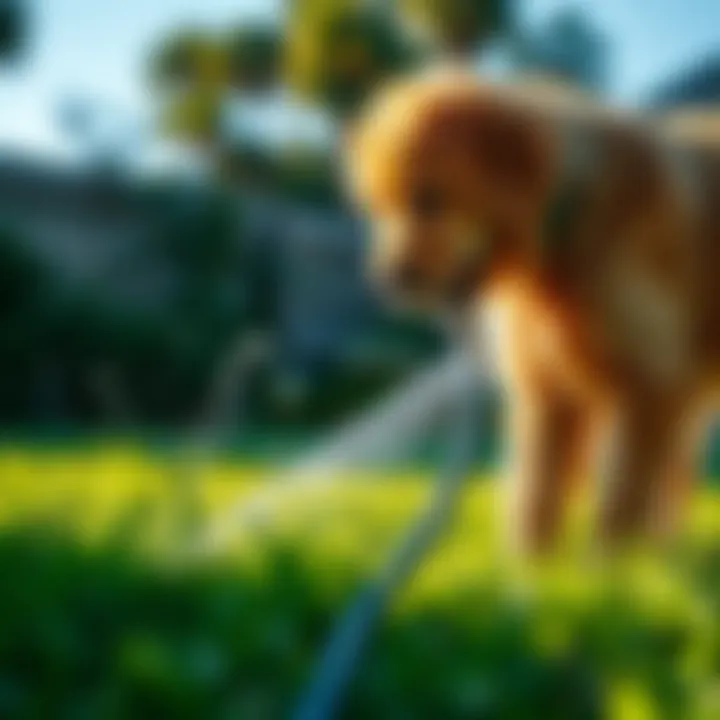
Recognizing symptoms in your lawn helps bridge the gap between the beauty of grassy areas and the responsibilities of pet ownership. By being proactive, you cultivate not just a garden, but also a deeper bond with your green spaces, ensuring they remain a joy for both you and your furry friends.
Prevention Techniques for Lawn Health
Preventing the negative effects of canine urine on lawns is not just about addressing symptoms—it's about adopting a holistic approach to lawn care. Effective prevention techniques can lead to healthier, more resilient grass and reduce the likelihood of damage. Doing this not only promotes the visual appeal of green spaces but also supports sustainable practices regarding pet ownership and landscaping. Here’s a closer look at two primary strategies: implementing basic lawn care practices and effective watering techniques.
Implementing Basic Lawn Care Practices
To cultivate a robust lawn, one must start with basic lawn care. This foundation creates an environment where grass can thrive despite the challenges posed by dog urine. Here are essential practices to consider:
- Soil Testing: Regularly test the soil to determine its pH levels and nutrient content. Grass thrives in balanced soil, and knowing what your lawn needs can help in making informed adjustments.
- Proper Mowing: Keeping the grass at the right height is critical. Mow routinely, but don’t cut it too short; a height of around three inches allows for deeper roots and better drought resistance.
- Aeration: Aerate the lawn once or twice a year. This process alleviates soil compaction, allowing air and nutrients to penetrate the ground more effectively. It’s like giving your lawn a good stretch after being cooped up!
- Fertilization: Using a slow-release fertilizer can nourish your grass over time, making it less susceptible to the nitrogen spikes from urine. With the right balance of nutrients, grass can better cope with the stresses caused by dog waste.
By incorporating these practices, lawn health becomes part of a routine rather than a reactive chore.
Watering Strategies to Mitigate Urine Effects
After laying a foundation through basic care, one can turn to watering strategies designed explicitly for mitigating urine damage. Water plays an integral role in diluting harmful substances and ensuring healthy grass. Here are key techniques to implement:
- Frequency and Depth: Water your lawn deeply but infrequently. This encourages root growth and helps grasses withstand the concentrated nitrogen levels from urine. Aim for around one inch of water per week, adjusting based on rainfall.
- Spot Watering: When a dog typically urinates in the same spot, try to spot water those areas immediately. Ensure that the urine is diluted as quickly as possible to lessen its adverse effects. A quick rinse can make a world of difference in preventing brown patches.
- Irrigation Timing: Watering during early mornings reduces evaporation, allowing more moisture to seep into the ground. Evening watering is also suitable, but be cautious of prolonged wet grass that can lead to fungal disease.
- Consider Drip Systems: If possible, incorporate a drip watering system for certain parts of your yard where your pet frequents. This fine-tuned approach ensures that these areas receive adequate moisture without saturating other sections of the lawn unnecessarily.
Regular watering can significantly reduce the damages caused by dog urine by diluting harmful chemicals, promoting a healthier, thriving lawn.
To sum up, preventive techniques for lawn health involve a combination of knowledge, routine care, and strategic watering. Implementing these methods can offer pet owners a practical way to keep their lawns vibrant and lush, all while being responsible stewards of their outdoor spaces.
Product Solutions: Urine Grass Savers
When it comes to keeping your lawn looking its best despite the occasional mishap from our canine companions, urine grass savers can be a game-changer. Understanding these solutions entails delving into their purpose, effectiveness, and a careful look at what's available in the market today. Pet owners and lawn lovers alike will find that these tools have become increasingly essential for fostering a healthier grass ecosystem, especially for those with a strong commitment to maintaining an attractive yard.
Understanding Urine Grass Savers
Urine grass savers are specialized products designed to tackle the problem of lawn burn caused by dog urine. They come in various forms—liquids, granules, and even supplements for your pet’s diet—each tailored to mitigate the effects of nitrogen and salts in canine urine. It's crucial to understand the ingredients and mechanisms of these products to make an informed decision. Typically, they work by neutralizing the harmful components in urine or by providing the lawn with beneficial nutrients that help it bounce back.
Think of them as the remedy for a pesky nuisance, restoring the health and vibrancy of your grass over time. Here’s a brief overview of what you might encounter:
- Liquid Solutions: These are sprayed or poured onto the affected areas. They often contain enzymes that break down nitrogen compounds.
- Granular Products: These can be spread throughout the lawn. They usually include nutrients aimed at enriching the soil and improving grass resilience.
- Dietary Supplements: These are intended for pets, designed to adjust the pH of their urine, making it less harmful to grass.
All these options reflect a growing understanding of how to coexist with our four-legged friends without sacrificing our verdant outdoor spaces.
How They Work: Science Behind the Solutions
To grasp how urine grass savers perform, a bit of chemistry is in order. Dog urine primarily consists of nitrogen, which while a nutrient for grass, can become concentrated and lead to noticeable damage. Serially, high salt levels can further exacerbate the issue, leading to desiccation and patchy growth.
Most urine grass savers work on the principle of dilution and nutrient balance. When applied, they often bring in:
- Nitrogen Stabilizers: They help to regulate the nitrogen release in the soil, preventing sudden spikes that contribute to burning.
- Restorative Nutrients: Products may introduce potassium or phosphorus, which are critical for grass recovery and overall health.
- Improved Soil Microbiology: Some solutions even enhance microbial activity in the soil, working to break down harmful compounds more efficiently.
Together, these elements aim to restore balance, allowing the grass to thrive while reducing the negative impact of pet waste.
Comparing Different Products on the Market
With a rising trend in lawn care innovation, it’s important to assess various urine grass savers available today. Here’s how you may compare them:
- Effectiveness: Look for products with proven results, backed by reviews and user experiences. Some homeowners swear by certain granules, while others may find liquid treatments more effective.
- Application Method: Consider how easy the product is to use. Spray bottles might be more convenient for quick touch-ups, while granules can be more suited for larger areas that need treatment.
- Safety for Pets: Not all products are created equal. Some might contain chemicals that could be harmful to pets if ingested, so always check the ingredient list before making a purchase.
- Cost-Effectiveness: Balance price against the size of the treated area. Some may be pricey but very effective; others may save money but lack the results you expect.
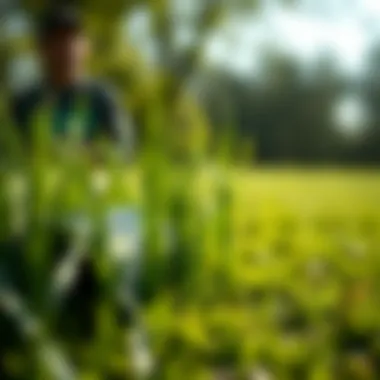
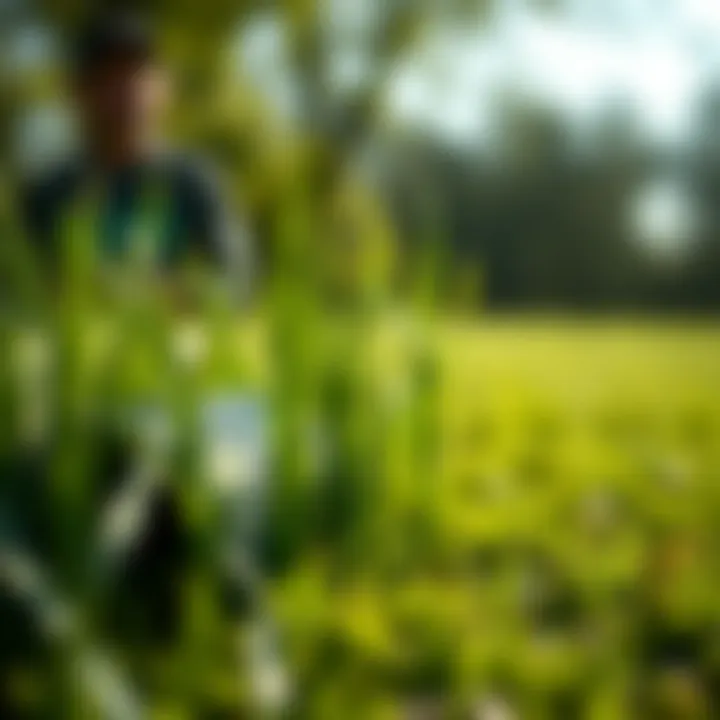
As you navigate the market, it’s wise to read reviews, visit discussion forums like those on Reddit, and perhaps even consult with local gardening stores for recommendations.
"A healthy lawn is a happy lawn, and with the right approach, you can have both a thriving yard and a content pet."
By leveraging the efficacy of urine grass savers wisely, you’ll be well on the path to achieving that lush green landscape you dream about, all while maintaining a harmonious bond with your furry friend. Great lawns don’t just happen; they require a solid partnership between thoughtful care and practical solutions.
Long-Term Lawn Care Strategies
Long-term lawn care strategies are crucial for maintaining the health and vitality of your grass while navigating the unique challenges posed by canine urine. Over time, the effects of dog urine can significantly alter the landscape of your lawn, leading to persistent problem areas, discoloration, and potentially, dead patches. Implementing a thoughtful lawn care plan that takes these factors into account can ensure that your grass remains lush and robust while also accommodating your furry companions.
Effective strategies often hinge on proactive planning and regular maintenance that not just combat existing issues but also prevent them before they arise. This long-term perspective is what sets successful lawn care apart from short-term fixes.
Choosing the Right Grass Types
Selecting the correct grass type is foundational for a resilient lawn. Different grasses have unique tolerances to various stressors, including urine. Here are some key considerations:
- Durability Over Aesthetics: Some grass varieties are more resilient than others. Kentucky bluegrass, for instance, is often favored for its appearance but can be sensitive to dog urine. On the other hand, fescue blends can handle the rigors better while staying green and robust.
- Native Grasses: Choosing native grasses can also enhance the lawn's resilience. These grasses are naturally adapted to the local environment and are often better able to withstand the impacts of pests and environmental changes.
- Dog-Resistant Varieties: Some grass types, like Bermuda grass or Zoysia grass, are known for their durability and might withstand urine impact better than more delicate options. When selecting grass for a lawn frequented by dogs, consider consulting local agronomy experts or extension services for tailored advice based on regional conditions.
Educating Pet Owners on Lawn Care
When it comes to maintaining a vibrant lawn, responsible pet ownership looms large. This isn't just about how our dogs behave outside; it's also about the consequences of their natural habits on our grassy patches. Having the knowledge to manage how dog urine affects lawns is imperative for both pets and the environment. An educated pet owner can transform a barren backyard into a lush green oasis.
Prioritizing education surrounding this issue holds immense benefits. For starters, if pet owners can grasp how canine urine affects grass, they can introduce practical measures to lessen that impact. This can lead to healthier yards, less frayed tempers from having to deal with dead patches, and ultimately a more harmonious relationship between pets and their environments.
Best Practices for Responsible Pet Ownership
Pet owners should consider a few best practices to protect their lawns and promote a more positive outdoor environment. These practices may include:
- Designating Potty Areas: Create a specific spot for your pets to relieve themselves. This not only confines the damage but also makes it easier to manage. Consider using materials like gravel that tend to withstand the effects of urine better than traditional grass.
- Training Commands: Train your pets to use the designated area. Use verbal cues like "go potty" or even simple hand signals to help guide them. Consistency is key; it may take a bit of coaxing at first, but pets usually adapt.
- Regularly Watering the Lawn: After your pet does their business, watering the area can dilute the urine's components. This is akin to putting a small fire out with some strategically placed water. It doesn’t eliminate the damage but helps spread it out, preventing any one spot from taking too much heat.
- Dietary Considerations: Sometimes, changing the pet’s diet can make a difference in the chemical composition of their urine. Ingredients that are rich in protein can elevate the nitrogen content, making lawn damage worse. Consulting with a vet to adjust your pet’s diet could yield positive results.
By adopting responsible practices, pet owners can foster healthier lawns while enjoying their time outdoors with their furry friends.
Creating Awareness in Communities
Community engagement is vital for addressing the impact of canine waste on local lawns. It starts with fostering a sense of collective responsibility among pet owners. Imagine a community where everyone is on the same page regarding lawn care; the effects would be especially striking.
Local organizations, such as neighborhood associations and parks departments, can play a pivotal role in spreading awareness. Some strategies include:
- Community Workshops: Organize informational sessions that educate pet owners about the impact of dog urine on lawns. Topics can range from basic lawn care to effective training techniques.
- Social Media Campaigns: Platforms like Facebook or community forums, such as Reddit, can be effective ways to circulate information about responsible pet ownership and its effects on the local environment.
- Signs and Reminders: Strategic placement of signs in parks and residential areas can serve as gentle reminders for dog owners to be aware of their pets' behavior. Clear indicators can lead to better habits and foster a sense of community pride.
- Collaborative Initiatives: Establish programs to create dog-friendly spaces that incorporate grass trees, mulch, or even specialized turf that withstands the effects of urine. Working together to solve these issues will yield better overall results.
Raising awareness is not just about getting the word out; it’s about building a culture of responsibility. This leads to better relationships between companions and their environments.
End
In wrapping up this discussion, it becomes clear just how essential it is to manage the impact of canine urine on lawns, especially for pet owners and garden enthusiasts. Pet ownership brings joy, but it also comes with responsibilities that extend beyond simply caring for the pet. The grass that lines our yards isn't just decor; it's a vital part of our outdoor ecosystem, providing beauty, play areas for pets and kids, and contributing to the environment.
Summary of Key Insights
One of the primary insights from this article is the chemistry of canine urine. Knowing that it contains nitrogen and salts can help owners understand why their grass may appear damaged after their pet does its business in the same spots repeatedly. To combat these issues, recognizing the discoloration patterns and assessing the overall health of the grass becomes fundamental. Establishing consistent lawn care practices is crucial—not just for the aesthetic appeal, but for promoting overall grass health. Equally important is fostering awareness among pet owners about responsible practices that contribute to healthier outdoor spaces.
An important takeaway is the effectiveness of preventive techniques, such as watering strategies and the use of urine grass savers. These methods can significantly mitigate the adverse effects of urine, enabling grass to thrive even in the presence of pets. By combining approaches from various angles—chemistry, pet care, and lawn health—we can foster greener and more resilient lawns.
Encouraging Sustainable Lawn Practices
With this knowledge in hand, it's time to advocate for sustainable lawn practices that benefit both pets and the greenery they walk upon. Fertilization should be balanced and cater to the specific needs of the lawn, perhaps relying on organic methods that minimize chemical runoff. Further, educating local communities on the importance of a robust lawn—be it for environmental reasons or merely keeping an attractive property—can initiate broader changes. Pet owners mustn’t shy away from alternative training methods to encourage their pets to use designated areas, thus reducing the concentration of urine in fragile spots.
To sum it up, keeping a healthy lawn while owning a pet is entirely achievable through informed practices and community education. Sustainable steps today can make the difference for green spaces tomorrow. By prioritizing these discussions, we can ensure a harmonious coexistence between our four-legged friends and the vibrant grass we treasure.
"A little effort in understanding and caring for our lawns goes a long way. It's not just about aesthetics; it’s about creating a sustainable environment for all."
For further reading and resources, consider checking Wikipedia and Britannica.















